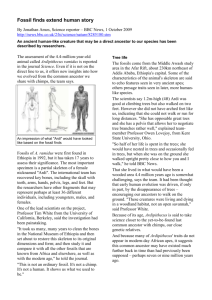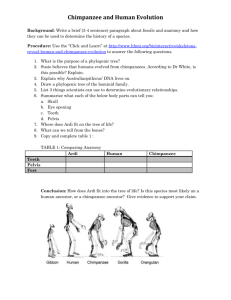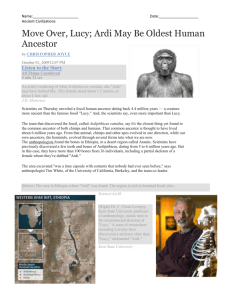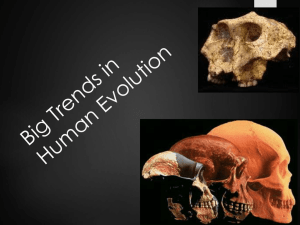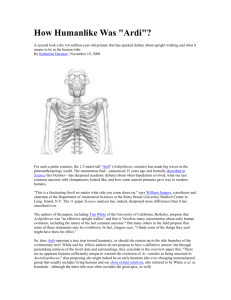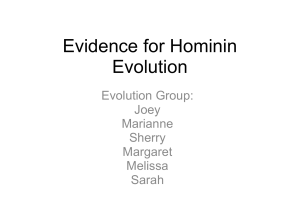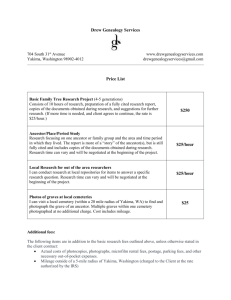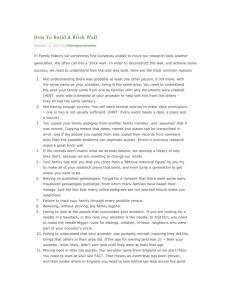Ardipithecus - Roosevelt High School
advertisement
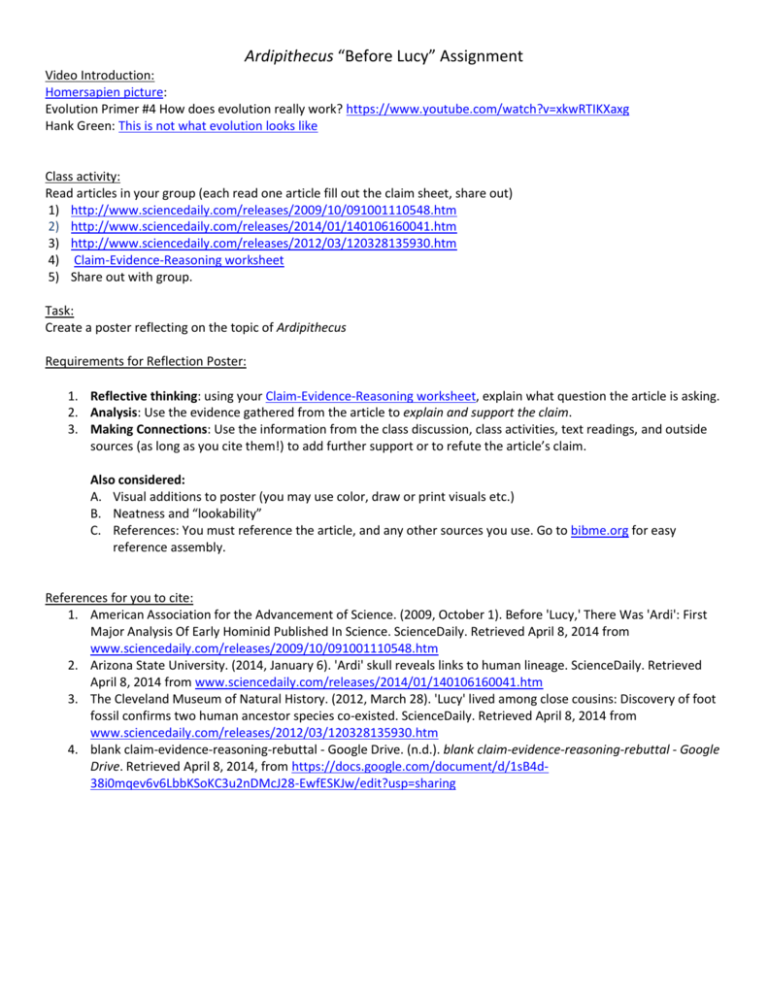
Ardipithecus “Before Lucy” Assignment Video Introduction: Homersapien picture: Evolution Primer #4 How does evolution really work? https://www.youtube.com/watch?v=xkwRTIKXaxg Hank Green: This is not what evolution looks like Class activity: Read articles in your group (each read one article fill out the claim sheet, share out) 1) http://www.sciencedaily.com/releases/2009/10/091001110548.htm 2) http://www.sciencedaily.com/releases/2014/01/140106160041.htm 3) http://www.sciencedaily.com/releases/2012/03/120328135930.htm 4) Claim-Evidence-Reasoning worksheet 5) Share out with group. Task: Create a poster reflecting on the topic of Ardipithecus Requirements for Reflection Poster: 1. Reflective thinking: using your Claim-Evidence-Reasoning worksheet, explain what question the article is asking. 2. Analysis: Use the evidence gathered from the article to explain and support the claim. 3. Making Connections: Use the information from the class discussion, class activities, text readings, and outside sources (as long as you cite them!) to add further support or to refute the article’s claim. Also considered: A. Visual additions to poster (you may use color, draw or print visuals etc.) B. Neatness and “lookability” C. References: You must reference the article, and any other sources you use. Go to bibme.org for easy reference assembly. References for you to cite: 1. American Association for the Advancement of Science. (2009, October 1). Before 'Lucy,' There Was 'Ardi': First Major Analysis Of Early Hominid Published In Science. ScienceDaily. Retrieved April 8, 2014 from www.sciencedaily.com/releases/2009/10/091001110548.htm 2. Arizona State University. (2014, January 6). 'Ardi' skull reveals links to human lineage. ScienceDaily. Retrieved April 8, 2014 from www.sciencedaily.com/releases/2014/01/140106160041.htm 3. The Cleveland Museum of Natural History. (2012, March 28). 'Lucy' lived among close cousins: Discovery of foot fossil confirms two human ancestor species co-existed. ScienceDaily. Retrieved April 8, 2014 from www.sciencedaily.com/releases/2012/03/120328135930.htm 4. blank claim-evidence-reasoning-rebuttal - Google Drive. (n.d.). blank claim-evidence-reasoning-rebuttal - Google Drive. Retrieved April 8, 2014, from https://docs.google.com/document/d/1sB4d38i0mqev6v6LbbKSoKC3u2nDMcJ28-EwfESKJw/edit?usp=sharing Claim-Evidence-Reasoning-Rebuttal Worksheet (adapted from AP Biology Summer Leadershop Academy) Group/ Period: _______________________________________________________________ Question Asked: Evidence from data & observations Scientific ideas, concepts, theories... Claim made (the claim should answer the question posed above): Explanation (discussion): (link your claim to the evidence and overall scientific concept): Rebuttals (list potential arguments against the claim): Before 'Lucy,' There Was 'Ardi': First Major Analysis Of Early Hominid Published In Science Date: October 1, 2009 Source: American Association for the Advancement of Science Probable life appearance in anterior view of Ardipithecus ramidus ("Ardi"), ARA-VP 6/500. Credit: Illustration copyright 2009, J.H. Matternes In a special issue of Science, an international team of scientists has for the first time thoroughly described Ardipithecus ramidus, a hominid species that lived 4.4 million years ago in what is now Ethiopia. This research, in the form of 11 detailed papers and more general summaries, will appear in the journal's 2 October 2009 issue. Science is published by AAAS, the nonprofit science society. This package of research offers the first comprehensive, peer-reviewed description of the Ardipithecus fossils, which include a partial skeleton of a female, nicknamed "Ardi." The last common ancestor shared by humans and chimpanzees is thought to have lived six or more million years ago. Though Ardipithecus is not itself this last common ancestor, it likely shared many of this ancestor's characteristics. For comparison, Ardipithecus is more than a million years older than the "Lucy" female partial skeleton of Australopithecus afarensis. Until the discovery of the new Ardipithecus remains, the fossil record contained scant evidence of other hominids older than Australopithecus. Through an analysis of the skull, teeth, pelvis, hands, feet and other bones, the researchers have determined that Ardipithecus had a mix of "primitive" traits, shared with its predecessors, the primates of the Miocene epoch, and "derived" traits, which it shares exclusively with later hominids. Because of its antiquity, Ardipithecus takes us closer to the still-elusive last common ancestor. However, many of its traits do not appear in modern-day African apes. One surprising conclusion, therefore, is that it is likely that the African apes have evolved extensively since we shared that last common ancestor, which thus makes living chimpanzees and gorillas poor models for the last common ancestor and for understanding our own evolution since that time. "In Ardipithecus we have an unspecialized form that hasn't evolved very far in the direction of Australopithecus. So when you go from head to toe, you're seeing a mosaic creature, that is neither chimpanzee, nor is it human. It is Ardipithecus," said Tim White of the University of California Berkeley, who is one of the lead authors of the research. "With such a complete skeleton, and with so many other individuals of the same species at the same time horizon, we can really understand the biology of this hominid," said Gen Suwa of the University of Tokyo, Project paleoanthropologist and also a lead Science author. "These articles contain an enormous amount of data collected and analyzed through a major international research effort. They throw open a window into a period of human evolution we have known little about, when early hominids were establishing themselves in Africa, soon after diverging from the last ancestor they shared with the African apes," said Brooks Hanson, deputy editor, physical sciences, at Science. "Science is delighted to be publishing this wealth of new information, which gives us important new insights into the roots of hominid evolution and into what makes humans unique among primates," said Hanson. The special collection of Science articles begins with an overview paper that summarizes the main findings of this research effort. In this article, White and his coauthors introduce their discovery of over 110 Ardipithecus specimens including a partial skeleton with much of the skull, hands, feet, limbs and pelvis. This individual, "Ardi," was a female who weighed about 50 kilograms and stood about 120 centimeters tall. Until now, researchers have generally assumed that chimpanzees, gorillas and other modern African apes have retained many of the traits of the last ancestor they shared with humans – in other words, this presumed ancestor was thought to be much more chimpanzee-like than human-like. For example, it would have been adapted for swinging and hanging from tree branches, and perhaps walked on its knuckles while on the ground. Ardipithecus challenges these assumptions, however. These hominids appear to have lived in a woodland environment, where they climbed on all fours along tree branches – as some of the Miocene primates did -- and walked, upright, on two legs, while on the ground. They do not appear to have been knuckle-walkers, or to have spent much time swinging and hanging from tree-branches, especially as chimps do. Overall, the findings suggest that hominids and African apes have each followed different evolutionary pathways, and we can no longer consider chimps as "proxies" for our last common ancestor. "Darwin was very wise on this matter," said White. "Darwin said we have to be really careful. The only way we're really going to know what this last common ancestor looked like is to go and find it. Well, at 4.4 million years ago we found something pretty close to it. And, just like Darwin appreciated, evolution of the ape lineages and the human lineage has been going on independently since the time those lines split, since that last common ancestor we shared," White said. This special issue of Science includes an overview article, three articles that describe the environment Ardipithecus inhabited, five that analyze specific parts of Ardipithecus' anatomy, and two that discuss what this new body of scientific information may imply for human evolution. Altogether, forty-seven different authors from around the world contributed to the total study of Ardipithecus and its environment. The primary authors are Tim White of the University of California, Berkeley, Berhane Asfaw of Rift Valley Research Service in Addis Ababa, Giday WoldeGabriel of Los Alamos National Laboratory, Gen Suwa of the University of Tokyo, and C. Owen Lovejoy of Kent State University. "These are the results of a mission to our deep African past," said WoldeGabriel, who is also Project co-Director and geologist. This research was funded by the National Science Foundation, the Institute of Geophysics and Planetary Physics of the University of California at Los Alamos National Laboratory (LANL), the Japan Society for the Promotion of Science, and others. Story Source: The above post is reprinted from materials provided by American Association for the Advancement of Science. Note: Materials may be edited for content and length. Journal Reference: 1. Brooks Hanson. Light on the Origin of Man. Science, 2009; DOI: 10.1126/science.326_60a 'Ardi' skull reveals links to human lineage Date: January 6, 2014 Source: Arizona State University The 4.4 million-year-old cranial base of Ardipithecus ramidus from Aramis, Middle Awash research area, Ethiopia. Credit: Image courtesy of Tim White One of the most hotly debated issues in current human origins research focuses on how the 4.4 million-year-old African species Ardipithecus ramidus is related to the human lineage. "Ardi" was an unusual primate. Though it possessed a tiny brain and a grasping big toe used for clambering in the trees, it had small, humanlike canine teeth and an upper pelvis modified for bipedal walking on the ground. Scientists disagree about where this mixture of features positions Ardipithecus ramidus on the tree of human and ape relationships. Was Ardi an ape with a few humanlike features retained from an ancestor near in time (between 6 and 8 million years ago, according to DNA evidence) to the split between the chimpanzee and human lines? Or was it a true relative of the human line that had yet to shed many signs of its remote tree-dwelling ancestry? New research led by Arizona State University paleoanthropologist William Kimbel confirms Ardi's close evolutionary relationship to humans. Kimbel and his collaborators turned to the underside (or base) of a beautifully preserved partial cranium of Ardi. Their study revealed a pattern of similarity that links Ardi to Australopithecus and modern humans, but not to apes. The research appears in the Jan. 6-10 online edition of Proceedings of the National Academy of Sciences. Kimbel is director of the ASU Institute of Human Origins, a research center of the College of Liberal Arts and Sciences in the School of Human Evolution and Social Change. Joining ASU's Kimbel as co-authors are Gen Suwa (University of Tokyo Museum), Berhane Asfaw (Rift Valley Research Service, Addis Ababa), Yoel Rak (Tel Aviv University) and Tim White (University of California at Berkeley). White's field-research team has been recovering fossil remains of Ardipithecus ramidus in the Middle Awash research area, Ethiopia since the 1990s. The most recent study of the Ardi skull, led by Suwa, was published in Science in 2009, whose work (with the Middle Awash team) first revealed humanlike aspects of its base. Kimbel coleads the team that recovered the earliest known Australopithecus skulls from the Hadar site, home of the "Lucy" skeleton, in Ethiopia. "Given the very tiny size of the Ardi skull, the similarity of its cranial base to a human's is astonishing," says Kimbel. The cranial base is a valuable resource for studying phylogenetic, or natural evolutionary relationships, because its anatomical complexity and association with the brain, posture and chewing system have provided numerous opportunities for adaptive evolution over time. The human cranial base, accordingly, differs profoundly from that of apes and other primates. In humans, the structures marking the articulation of the spine with the skull are more forwardly located than in apes, where the base is shorter from front to back and the openings on each side for passage of blood vessels and nerves are more widely separated. These shape differences affect the way the bones are arranged on the skull base, such that it is fairly easy to tell apart even isolated fragments of ape and human basicrania. Ardi's cranial base shows the distinguishing features that separate humans and Australopithecus from the apes. Kimbel's earlier research (with collaborator Rak) had shown that these human peculiarities were present in the earliest known Australopithecus skulls by 3.4 million years ago. The new work expands the catalogue of anatomical similarities linking humans, Australopithecus and Ardipithecus on the tree of life, and shows that the human cranial base pattern is at least a million years older than Lucy's species, A. afarensis. Paleoanthropologists generally fall into one of two camps on the cause of evolutionary changes in the human cranial base. Was it the adoption of upright posture and bipedality that caused a shift in the poise of the head on the vertebral column? If so, does the humanlike cranial base of Ar. ramidus confirm postcranial evidence for partial bipedality in this species? Or, do the changes tell us about the shape of the brain (and of the base on which it sits), perhaps an early sign of brain reorganization in the human lineage? Both alternatives will need to be re-evaluated in light of the finding that Ardi does indeed appear to be more closely related to humans than to chimpanzees. "The Ardi cranial base fills some important gaps in our understanding of human evolution above the neck," adds Kimbel. "But it also opens up a host of new questions . . . just as it should!" Story Source: The above post is reprinted from materials provided by Arizona State University. The original item was written by Julie Russ, Institute Of Human Origins. Note: Materials may be edited for content and length. Journal Reference: 1. William H. Kimbel, Gen Suwa, Berhane Asfaw, Yoel Rak, and Tim D. White. Ardipithecus ramidus and the evolution of the human cranial base. Proceedings of the National Academy of Sciences, 2014 DOI: 10.1073/pnas.1322639111 'Lucy' lived among close cousins: Discovery of foot fossil confirms two human ancestor species co-existed Date: March 28, 2012 Source: The Cleveland Museum of Natural History The Burtele partial foot (BRT-VP-2/73). A laboratory photo after cleaning and preparation. It is shown here in its anatomically articulated form. Credit: © The Cleveland Museum of Natural History Photo courtesy: Yohannes Haile-Selassie A team of scientists has announced the discovery of a 3.4 millionyear-old partial foot from the Woranso-Mille area of the Afar region of Ethiopia. The fossil foot did not belong to a member of “Lucy’s” species, Australopithecus afarensis, the famous early human ancestor. Research on this new specimen indicates that more than one species of early human ancestor existed between 3 and 4 million years ago with different methods of locomotion. The analysis will be published in the March 29, 2012 issue of the journal Nature. The partial foot was found in February 2009 in an area locally known as Burtele. “The Burtele partial foot clearly shows that at 3.4 million years ago, Lucy’s species, which walked upright on two legs, was not the only hominin species living in this region of Ethiopia,” said lead author and project leader Dr. Yohannes Haile-Selassie, curator of physical anthropology at The Cleveland Museum of Natural History. “Her species co-existed with close relatives who were more adept at climbing trees, like ‘Ardi’s’ species, Ardipithecus ramidus, which lived 4.4 million years ago.” The partial foot is the first evidence for the presence of at least two pre-human species with different modes of locomotion contemporaneously living in eastern Africa around 3.4 million years ago. While the big toe of the foot in Lucy’s species was aligned with the other four toes for human-like bipedal walking, the Burtele foot has an opposable big toe like the earlier Ardi. “This discovery was quite shocking,” said co-author and project co-leader Dr. Bruce Latimer of Case Western Reserve University. “These fossil elements represent bones we’ve never seen before. While the grasping big toe could move from side to side, there was no expansion on top of the joint that would allow for expanded range of movement required for pushing off the ground for upright walking. This individual would have likely had a somewhat awkward gait when on the ground.” The new partial foot specimen has not yet been assigned to a species due to the lack of associated skull or dental elements. The fossils were found below a sandstone layer. Using the argon-argon radioactive dating method, their age was determined to be younger than 3.46 million years, said co-author Dr. Beverly Saylor of Case Western Reserve University. “Nearby fossils of fish, crocodiles and turtles, and physical and chemical characteristics of sediments show the environment was a mosaic of river and delta channels adjacent to an open woodland of trees and bushes,” said Saylor. “This fits with the fossil, which strongly indicates a hominin adapted to living in trees, at the same time ‘Lucy’ was living on land.”
